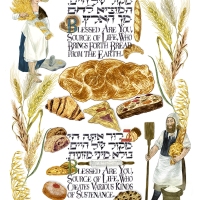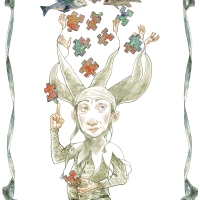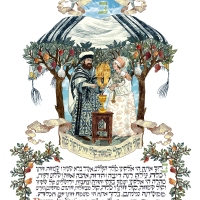For this fifth drawing from my Codex Gastropoda series, I was inspired by a cartoon which recently appeared in the online Tablet Magazine, drawn by the playwright David Mamet (http://www.tabletmag.com/scroll/54112/a-very-special-message/). So, in addition to The Time Snails posted a few days ago, here is a postscript New Year Wish for Good Fortune to all of Imaginarius’ visitors! I imagined the traditional forms of snails’ shells morphing into the equally intriguing shapes of a Chinese fortune cookies; which will you choose?
Posts Tagged ‘earth’
Codex Gastropoda #4:The Time Snails
December 26, 2010 The onset of a new year often inspires sentiments revolving around endings and beginnings. These might be memories accumulated over the year past and/or resolutions slated to inform the coming year. Both are part of our big picture, but share an underlying urgency to affect change in our lives and in the lives of those with whom we interact. Inevitably we all wish for more time to bring these new realities into being. The irony is that the process of time in the known universe remains a universal mystery even as we create methods for containing and measuring it. In that sense, time as a human construct theoretically offers us more power to use it than we often wish to acknowledge. Though the construct of ‘leap years’ are a familiar phenomenon, ‘leap seconds’ and the need to insert them into our time systems are relatively obscure. Since 1972, the ‘temporal authorities’ of The International Earth Rotation Services of the Bureau of Weights and Measures, at Paris, France, have slipped an extra ‘leap second’ into the calendar, making their decision to do so either on June 30 or December 31 of the target year. This was done to maintain the accuracy of atomic clocks that are affected by the irregular spin of the Earth, which seems to be slowing down. December 31 of 2010 is being considered for the next insertion. If this is not done conscientiously, they claim, then after several centuries, the time discrepancy would amount to one whole hour or more. With all the time we spend online and in pursuit of less than world-changing activities, many of us probably wouldn’t notice. Anyway, most clocks are not designed to accommodate leap seconds and because we are so synced to automated systems, there is the potential to mess with our minds that defies logic. Remembering the pre-email days of frantic deadlines for illustration assignments, it would’ve been handy to offer the following scenario to a client: “Well, I’d love to have this drawing ready for you tomorrow, but according to temporal authorities, if I don’t have another day to work on it, time as we know it will bend out of recognition, worlds will collide and the universe will pretty much descend into utter chaos as a result. Will Wednesday be okay?”
The onset of a new year often inspires sentiments revolving around endings and beginnings. These might be memories accumulated over the year past and/or resolutions slated to inform the coming year. Both are part of our big picture, but share an underlying urgency to affect change in our lives and in the lives of those with whom we interact. Inevitably we all wish for more time to bring these new realities into being. The irony is that the process of time in the known universe remains a universal mystery even as we create methods for containing and measuring it. In that sense, time as a human construct theoretically offers us more power to use it than we often wish to acknowledge. Though the construct of ‘leap years’ are a familiar phenomenon, ‘leap seconds’ and the need to insert them into our time systems are relatively obscure. Since 1972, the ‘temporal authorities’ of The International Earth Rotation Services of the Bureau of Weights and Measures, at Paris, France, have slipped an extra ‘leap second’ into the calendar, making their decision to do so either on June 30 or December 31 of the target year. This was done to maintain the accuracy of atomic clocks that are affected by the irregular spin of the Earth, which seems to be slowing down. December 31 of 2010 is being considered for the next insertion. If this is not done conscientiously, they claim, then after several centuries, the time discrepancy would amount to one whole hour or more. With all the time we spend online and in pursuit of less than world-changing activities, many of us probably wouldn’t notice. Anyway, most clocks are not designed to accommodate leap seconds and because we are so synced to automated systems, there is the potential to mess with our minds that defies logic. Remembering the pre-email days of frantic deadlines for illustration assignments, it would’ve been handy to offer the following scenario to a client: “Well, I’d love to have this drawing ready for you tomorrow, but according to temporal authorities, if I don’t have another day to work on it, time as we know it will bend out of recognition, worlds will collide and the universe will pretty much descend into utter chaos as a result. Will Wednesday be okay?”
On that thought, I’ve resolved to reset my clocks on December 31 and gather my grand plans for 2011. Here’s wishing you all the time you need for yours in the New Year, too…
Codex Gastropoda #3:The Unbearable Slowness of Reading
December 19, 2010The German writer and polymath Johann Wolfgang von Goethe is credited with observing that “thinking is more interesting than knowing but not so interesting as looking.” Visually tethered to technology as we are, this casual aphorism characterizes our global culture in ways he could not have imagined, yet would probably have embraced with equal enthusiasm. But is our fascination with high-speed looking diminishing our ability to think analytically and understand the consequences of our thoughts and actions? I fear that to some degree it is. And books, those tactile reliquaries of conversations with minds great and small are becoming casualties in a virtual battle between the Warriors of the Printed Word and the Knights of the Kindle. Although this entry was composed on my iPhone (sigh!) ‘The Burden of Knowledge’ shown above was drawn with these thoughts in mind and in memory of the pleasures of the ‘Unbearable Slowness of Reading’.
A Vintage Virgo: From The Alchymical Zoodiac
September 12, 2010 Each year at this time, my perceptions and energies seem preternaturally focused. Considering my September 13 birth date, is this a given? Or do we all find ourselves in this state on or around our birthdays throughout the year? Those who subscribe to astrological analysis with an emphasis on sun signs will confidently point to the sign of the zodiac in a certain position over the ecliptic and nod sagely. The history of science credits ancient astronomy and medieval alchemy as precursors to our understanding of the workings of creation and our role in it. While astrology’s readings of our personalities and events have also been part of human culture for millennia, our conventional science has yet to provide proof of this connection and has relegated astrology to the fiefdom of the foolish. Intuition suggests that this categorization of astrology may be premature; there is still much to learn about ourselves if we can move past its early efforts and allow its wisdom to augment our own. These sentiments inspired my creation of The Alchymical Zoodiac: A Celestial Bestiary (Imaginarius Editions, 2009) which may be purchased at my website: http://www.winnlederer.com/zoodiacbook/default.htm
Each year at this time, my perceptions and energies seem preternaturally focused. Considering my September 13 birth date, is this a given? Or do we all find ourselves in this state on or around our birthdays throughout the year? Those who subscribe to astrological analysis with an emphasis on sun signs will confidently point to the sign of the zodiac in a certain position over the ecliptic and nod sagely. The history of science credits ancient astronomy and medieval alchemy as precursors to our understanding of the workings of creation and our role in it. While astrology’s readings of our personalities and events have also been part of human culture for millennia, our conventional science has yet to provide proof of this connection and has relegated astrology to the fiefdom of the foolish. Intuition suggests that this categorization of astrology may be premature; there is still much to learn about ourselves if we can move past its early efforts and allow its wisdom to augment our own. These sentiments inspired my creation of The Alchymical Zoodiac: A Celestial Bestiary (Imaginarius Editions, 2009) which may be purchased at my website: http://www.winnlederer.com/zoodiacbook/default.htm
Happy Birthday, fellow Virgoans (August 22nd-September 23rd)!










Famous Last Words: V’Zot Ha-B’Rakhah
September 28, 2010“V’Zot Ha-B’Rakhah” or ‘this is the blessing’ are the words that begin Moses’ final address to the tribes of Israel preceding his death. It is a poetic rendering of blessings in the tradition of the patriarch Jacob. Both insightful and prophetic, the blessings describe the psychological nature of each tribe while prophesying their future actions in accordance with those characteristics. The tribes have exhibited and witnessed every duality in human nature during their 40 year journey, yet they have also been prepared to understand that they must become a model for humanity when they enter the Promised Land. To be worthy of God’s vision and blessings, they must develop the Land and refine their behavior according to the blueprint (Torah) that is God’s gift to them through Moses.
On Simchat Torah, the closing festival of the Jewish year, the reading of V’Zot HaBrakhah completes the annual Torah cycle. Accordingly, here are my illustrations for this parashah from Between Heaven & Earth: An Illuminated Torah Commentary (Pomegranate, 2009) . To the right of the quotation, a large Hebrew letter ‘bet’ encloses the words, ‘Hazak, Hazak, V’Nithazek’. In a tradition that originated in the late 12th-13th century by Jews in France, Germany and Spain, this phrase is pronounced at the completion of the Torah cycle. In some Ashkenazic communities, it is pronounced after reading each individual book of the Torah. ‘Hazak…’ is an interpretation of the verse in the Book of Joshua (1:6-8), “Be strong, Joshua, be of good courage…this book of the Law shall not depart from your mouth.” The phrase appears within the ‘bet’ as in ‘Beresheit’ and as a reminder that each contains the other in the duality of beginnings and endings just as a question often contains its own answer yet leads to another question.
The Shekhinah figure to the right of Moses supports a shining breastplate that frames twelve gems representing each tribe above a prominent pavilion, ‘the House of Israel’. She wears an ornate crown of golden pomegranate branches that culminate in a large perfect fruit. The Hebrew letter ‘kaph’ which in kabbalah is the highest sefirot of ‘keter’ surmounts her crown while the letter ‘mem’ is the key element at the base, signifying the unification of heaven and earth. Moses, ethereal in pale earth tones heralding his imminent death stands on a windswept Mt. Nebo, his eyes raised in a last conversation with God and His Shekhinah. His state of spiritual completeness in their relationship is evident by the configuration of the Hebrew letters ‘dalet’ and ‘taph’ for the sephirot ‘da’at’ and ‘tiferet’. These merge the qualities of human and divine, revealing the path of return to his origins; for he now understands the fundamental import of his mission and the majestic legacy he has imparted to his people.
At the final appearance of the celestial mask of God in this book, note that it now appears above the Shekhinah where in Genesis (Parashah Beresheit), it was the foremost image in the illustration. I have done this to emphasize that while God and His Shekhinah are two aspects of One, She is His spiritual ambassador whom we greet each Sabbath and through whom we honor the unity that is God. I must also include some additional comments on the design of these two images. First of all, no disrespect is intended to anyone who abhors any ‘image’ of God. Throughout the Torah, God is described as though He possessed ‘physical’ human features. Perhaps the common translations of Genesis stating that we are made in ‘His Image ‘gave rise to its simplistic inverse suggestion that ‘He’ ‘looks’ like us, but inconceivably larger. Nevertheless, since the central concept of monotheism is that God cannot be ‘seen’, common sense asserts that terms such as ‘the eyes of God’ or the ‘breath of God’ are merely metaphors because the Torah was written for human comprehension. So it is with this mask, intended as a reminder that to seek God’s wisdom and blessings, we must look beyond any ‘masks’ into our own hearts.
With best wishes for a healthy, thoughtful and productive year…
Between Heaven & Earth: An Illuminated Torah Commentary may be ordered from:
Pomegranate: http://www.pomegranate.com/a166.html Ph: 1.800.227.1428
Amazon: amzn.to/gZSp5j
Tags:bereshith, Bible, blessing, breastplate, breath of god, choshen, Commentary, crown, earth, eyes of god, hazak, heaven, Hebrew, illumination, israel, jacob, jewish judaism, Judaica, Kabbalah, manuscript, Moses, Old Testament, parashah, pomegranate, promised land, prophecy, Sefirot, shekhinah, shemini atzeret, simchat, Torah, tribes, twelve
Posted in A Visual Amidah: An Essence Of Prayers & Blessings | 2 Comments »